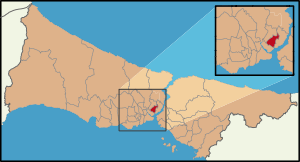Pangaltı
Pangaltı (spelled Pangaaltı or Pancaldi in some older sources) is one of the four neighbourhoods (together with Teşvikiye, Maçka and Osmanbey) within the Nişantaşı quarter of the Şişli district in Istanbul, Turkey.
Pangaltı | |
|---|---|
 Location of Şişli in Istanbul | |
| Coordinates: 41°03′5.94″N 28°59′15.2376″E | |
| Country | |
| Province | Istanbul |
| District | Şişli |
| Time zone | GMT +2 |
| Area code(s) | (+90) 212 |
It is home to the Cathedral of the Holy Spirit and Pangaltı Catholic Cemetery, the largest Catholic cemetery in Istanbul.
History
The neighborhood was formerly inhabited mainly by Levantine Christians.[1][2][3] The Ottoman Army War College founded by Sultan Mahmud II had its headquarters in this city quarter from 1848.[4][5]
As part of the 1860s redevelopment of Istanbul, when the avenue between Taksim and Pangaltı was under construction in 1864, Christian cemeteries in Taksim were moved to Şişli[6] and a garden-park (Taksim Gezisi) was arranged in their place. The Anarad Hiğutyun (Armenian for "Immaculate Conception") Armenian Catholic Church (Anarad Hiğutyun Ermeni Katolik Kilisesi ) was built in 1866 in timber, and from 1971-1973 rebuilt in stone.[7][8]
The Private Armenian School of Pangaltı (former Mihitaryan Ermeni Mektebi or "Mihitaryan School"), established in Kandilli in 1811 serves the public in the quarter since 1866.[9] It was associated with the school of the Armenian Sisters of the Immaculate Conception who were founded in Istanbul in 1847. The school continues today.[10]
See also
References
- Rinaldo Marmara Pancaldi: quartier Levantin du XIXe siècle Editions Tsis, Istanbul, 2004 Page 49 "Au début du XXe siècle, Pancaldi était un quartier à 95 % chrétien. L'origine des noms des personnes habitant ce quartier nous permet d'avancer cette hypothèse. Les étrangers ou Levantins et les Latins ottomans vivaient en compagnie des Grecs et des Arméniens. La confirmation du pourcentage et aussi du voisinage des Levantins et des minorités, nous la trouvons dans VAnnuaire Oriental de 1913, où figurent les habitants de chaque rue des différents quartiers1 de la ville. Après avoir regroupé toutes les rues du quartier Pancaldi indiquées dans l'Annuaire Oriental, nous avons relevé les noms des personnes qui y habitaient. Le caractère chrétien du tissu social de ce quartier est incontestable, et, franchissant un pas de plus, nous avons essayé de réaliser un pourcentage approximatif de ses habitants selon l'origine (latine, grecque, arménienne) de leurs noms."
- Edmondo De Amicis 1878 "PANCALDI Nous sortons du cimetière, nous nous trouvons dans un autre quartier chrétien, Pancaldi, traversé par des rues ... neufs, entouré de d'arabesques, comme la nef d'une mosquée. Dans ces rues à 56 CONSTANTINOPLE. Pancaldi.
- Pacificateurs Page 92 "Au centre sacré de l'Orthodoxie, qui siège au Phanar, quartier d'Istanbul, c'est le souci œcuménique qui, depuis des siècles, tel un ... Au Requiem du 17 octobre, en l'église du Saint-Esprit, à Pangalti d'Istanbul, le patriarche fait transmettre ses condoléances par le protosyncelle Émilianos et par le secrétaire en chef du Saint-Synode permanent, Siméon."
- Henry Montague Hozier The Russo-Turkish war Volume 1, Part 2 - Page 370 - 1878 "The Imperial Military College at Pancaldi was founded by Sultan Mahmoud II. The instruction at this college is excellent; but it begins at the wrong end, and turns out captains instead of sublieutenants. The course of studies extends over five years..."
- Journal of the Military Service Institution of the United States Military Service Institution of the United States Volume 48 1911 Page 135 - "After the revolution of July 23, 1908, and the inauguration of parliamentary government, the project of abolition could not be carried out and the School at Pancaldi was re-established with its former organization for the resumption of the course ..."
- Zeynep Çelik The Remaking of Istanbul: Portrait of an Ottoman City in the Nineteenth Century, Seattle and London, University of Washington Press. 1986, Page 69 - 1986 "Another significant task undertaken in this period was the connecting of the new neighborhoods of Pangalti (planned in 1848) and Taksim, which was little more than a large open space covered with Christian cemeteries at the northern end of the Grande Rue. A wide road (tarik-i vaz) between Taksim and the Military School in Pangalti, first proposed in 1862, was completed in 1869. 85 This tree-lined artery was soon extended to Şişli. .. In 1864, when the road between Taksim and Pangalti was under construction, the Christian cemeteries in Taksim were moved to Şişli, and a garden was planned for the area previously occupied by the cemeteries"
- Pars Tuğlacı Armenian churches of Istanbul Page 1991 290 "ANARAD HIGHUTIUN CHURCH (РапдаШ) This chapel in Pangalti was built of timber by one of the Viennese Militarist monks. It took three years to build and opened on 24 November 1866. In 1901 it was enlarged and repaired, and in 1971 rebuilt in stone. It reopened on 11 June 1973 and is still used today. "
- https://web.archive.org/web/20120913075653/http://www.gezgindergi.com/2011/05/16/istanbul%E2%80%99da-bir-katolik-ermeni-okulu-pangaalti-mikhitaryan-ermeni-mektebi/. Archived from the original on September 13, 2012. Retrieved December 29, 2012. Missing or empty
|title=(help) - (check, source does not give this) Archived September 13, 2012, at the Wayback Machine
- John XXIII, friend of the Turks - Page 21 Rinaldo Marmara - 2000 "On 31 May 1942 in a conversation with the students of the Armenian Sisters of the Immaculate Conception School in Pangalti, .."